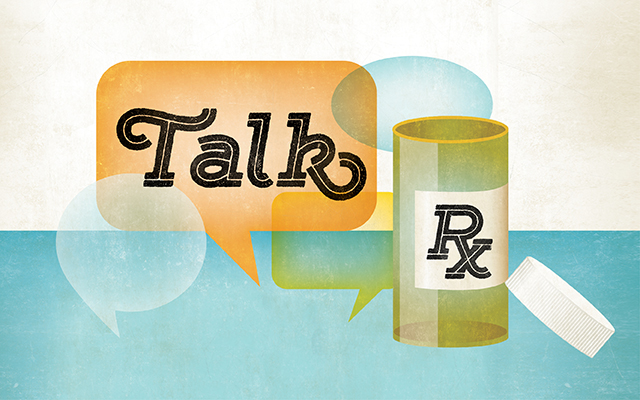No one wants to be in the hospital over the holidays (doctors included), so it was no shock when my patient with uncontrolled diabetes became temperamental and started throwing green Jell-O. What did surprise me was how much his attitude changed when I sat with him for a while and asked a few questions. Not only did he calm down in the moment, but I received a thank-you note from him six months later. He shared that, after leaving the hospital and using the “awareness prescription” I’d written him, he had lost 30 pounds and was reestablishing relationships with estranged family members.
After spending more than 15 years as a board-certified internist, exploring the roots of physical illness, I’m convinced that communication is tied inextricably to our overall health. I believe it’s so vitally important to health that I transitioned from being a hospital physician to creating my own private practice where I focus on stress management through mindfulness and improving people’s communication.
Think about how many conversations you have every day — from one-word exchanges to hourlong talks. When communication breaks down in any interaction, even if it’s momentary, your heart rate speeds up. Your blood pressure, cholesterol, and blood-sugar levels rise.
People who feel misunderstood report a higher incidence of depression. Depression leads to a weakened immune system — your primary defense against disease. Under prolonged and demoralizing stress, you become susceptible to ailments such as headaches, digestive issues, type 2 diabetes, and heart disease, to name a few.
Communication is one of the primary tools for creating good relationships — which have a powerful positive impact on well-being. Healthy communication leads to growth, love, support, friendship, and healing. (
Unhealthy communication can produce the opposite.
Because my patients were often hospitalized in critical condition, long-lost friends and loved ones would frequently show up to visit them: a college roommate who was finally willing to forgive and forget. Nephews who had been too busy to visit. Or an ex-husband or disowned daughter.
This, I realized, was an opportunity not to be missed — especially once I began to see the connection between my patients’ illnesses and the miscommunications in their lives.
So I began teaching them some basic techniques I had learned when my own health faltered from the stress of self-neglect and too many 36-hour shifts. As my patients courageously opened up about their emotions and desires, something started to happen: Their symptoms began to reverse.
Blood-sugar levels began to normalize. Asthmatic patients were released ahead of schedule. And nurses were getting paged half as often.
What was happening?
Quite simply, people started to make connections between their internal and external states of health. When they expressed themselves fully and honestly, they felt better — and often, they got better. I call the questions I used to guide them the “awareness prescription.”
Read on to learn how it works, and how you can improve communication with the people you care about — before you get sick.
The Awareness Prescription
Five questions that help uncover the heartaches behind our physical ailments.
After that conversation with my diabetic patient, I started using the awareness prescription to help my patients heal. As soon as they were medically stable, I wrote these five questions on my prescription pad to prompt them to explore and identify links between their physical health and other aspects of their lives.
I wasn’t asking patients to cross items off a to-do list. All that mattered was that they began connecting their symptoms with their external circumstances, their patterns of behavior, their relationships, and their emotional truth.
Q 1: Why This?
Why a stroke? Why pneumonia? Why a heart attack?
There’s a physical explanation for why a particular part of the body breaks down. That’s the pathology. But beyond the bacteria that cause a disease or the hormone that’s out of balance, there’s often a deeper message. When the body suffers distress, it’s important that we look beyond the textbook definition of a disease or the numbers from a lab test. If a patient has back pain, for example, maybe she feels the weight of the world on her shoulders, or doesn’t feel supported. Maybe she isn’t standing up for herself.
Q 2: Why Now?
Why is this happening to a patient at a particular point in time?
Maybe the stress in his life was increasing until his body wouldn’t allow him to ignore it anymore. Or possibly his patterns of behavior toward others had created a negative impact on his relationships, and this was how his body forced him to admit his feelings of remorse. Perhaps he had suppressed some wound from the past for so long that his body was finally pushing him to confront it. Or perhaps there had been some recent stressful event that corresponded to the beginning of the ailment, as when my younger sister developed gastric reflux almost immediately after learning that a dear friend had become gravely ill.
Q 3: What Might You Have Missed?
My patients often believed that a disease had hit them all of a sudden. But, in fact, their bodies had been changing over time and likely giving off signals along the way — like shortness of breath weeks before a heart attack. They just didn’t know how to interpret these warning signs. Or maybe they weren’t listening.
Q 4: What Else Needs to Be Healed?
The physical ailments the body exhibits usually reflect the pain and suffering, the miscommunication, the disconnected relationships, and the imbalances in someone’s external life. These unresolved issues create the stress that in turn breaks down the body’s ability to prevent illness and to heal. If these external sources of stress remain unchanged, the body will continue to get sick — even with the best treatment.
A “lifetime” of insomnia might have begun at the start of a high-pressure job a decade ago. Chronic constipation might be related to a need for control. Noticing the stories that might be behind our symptoms is just as important as attending to niggling physical symptoms. Unhealthy stories can keep us trapped in unhealthy bodies.
Q 5: If You Spoke from the Heart, What Would You Say?
When patients hear this final question, they often sigh with relief: It’s as if they’ve received permission to speak the truth out loud after keeping it hidden for so long — even from themselves.
Most of us speak from our heads. We will gladly share what we think or observe. We’re happy to reveal our opinions about the actions of others, and we offer advice whether it’s asked for or not. When we’re upset, we often talk about other people rather than to them. But how often are we willing to travel those 18 inches from our heads to our hearts to talk about what we truly feel and desire?
i-Five Communication
A method for healing our connections with ourselves and others.
Today, I teach the same practical tools of communication to my clients that I discovered with my hospital patients to help them create good communication.
I call my framework the i-Five conversation. The “i” stands for “identify, interpret, and integrate.” The “five” references the five key components of clear communication presented at right.
Once you know how to communicate more effectively, you’ll improve your relationship with both yourself and the world around you. You’ll also take care of your health simultaneously.
It starts with everyday conversations, whether you’re handling a challenging exchange at work or simply sharing something with a loved one. You don’t have to wait for someone else to change to express yourself clearly. The power of good communication starts with you.
Working through this process will help you become curious instead of furious when things don’t go your way. It will help you quit projecting stories and feelings onto other people.
In short, it will keep the lines of communication open, so you’re not harboring (or provoking) the kind of resentments and mistaken beliefs that can ultimately make you sick.
Your Body
Identify and interpret signals coming from your physical systems.
Your body is a finely tuned instrument that allows you to experience the multisensory world. If you listen to your body, it will provide you with valuable information that will help you communicate more precisely. So this is where an i-Five conversation starts. Look outward and inward. Your senses will pick up information from the outside world, and your physiology will send signals about your inside world. What do they say? The following questions will help you tune in:
- External data: What do you notice? What do you see, hear, taste, touch, or smell? In conversation, what body language, tone, or words have you picked up on, in someone else or yourself? What has changed?
This information allows you to start a conversation on neutral ground, by stating what you’ve observed objectively.
- Internal data: What are your internal physical signals — heart racing, stomach turning, sweating? If you think you’re reacting rather than responding, hit your internal pause button before going further.
Your Mind
Identify and interpret stories in your head.
To simplify the world, we often think in black and white. But there are endless ways to piece together data. Unless we challenge and examine the stories in our heads — the ones about how we’re right and other people are wrong — we’ll never know what’s actually true, or be able to perceive other possibilities.
Here are a few questions to help you identify the stories in your head, so you can decide whether or not to believe them:
- What are the stories you’ve made up? (It’s a “story” if you don’t have objective data for this belief.)
- Are your stories mostly about the other person, or you?
- What else could be going on in the other person’s life or environment that you might not be aware of?
- What is your part in this situation?
- Is there something you might not have taken responsibility for?
Once you’ve identified your stories, you can stick to what really needs to be communicated — instead of getting caught in a defensive battle about whether your story is true.
Your Feelings
Identify and interpret your emotions.
Let’s face it: Some emotions can be awkward, uncomfortable, and messy. They take up time you don’t have. They make conversations heavy. Still, I’ve learned that if you lean into your feelings, you can move through them without getting stuck. Emotions are neither good nor bad; they are simply a powerful indicator of how you are connecting to your life in this moment.
A key step in any i-Five conversation is identifying what you’re feeling in a simple, uncomplicated way. This information is vital to connecting from the heart, not just the head. What’s more, when you are ambiguous about what you feel, others fill in the blanks about what’s going on for you. Then you make up stories about their stories, and they make up stories about your stories, and on and on. So you can see how naming your own feelings is really a timesaver.
Ask yourself:
- How do I feel (happy, sad, angry, joyful, jealous, nervous, irritated, excited)? If you’re wondering about how to distinguish between expressing a thought and expressing an emotion, here’s a handy trick:
- Thoughts = “I feel like” + a string of words including, but not limited to, an explanation, an opinion, or a story.
- Emotions = “I feel” + one-word emotion (elated, angry, peaceful).
Your Wishes
Identify and interpret your desires.
Knowing what you want is different from being able to interpret your desires. Interpreting your desires is based on knowing what you want and understanding the motivation beneath it — what you value.
Knowing what you want and what you value provides the clarity to make decisions in everyday conversations with ease and gives you the confidence to take bold action when necessary. In addition, you’ll be able to listen for others’ values in conversation, which will allow you to identify common ground and create connection.
Before beginning any important conversation, ask yourself these questions:
- What do I want?
- What do I value in this relationship, situation, conversation, or request?
- What attitude (or internal state of being) do I want to bring to this conversation?
- What am I trying to achieve?
- What am I trying to protect myself from?
- What am I trying to change so I can be more comfortable, happy, peaceful (or whatever your desire is)?
Assuming the other person’s behavior remains the same, what do I want for myself in this situation? If you’re having a hard time figuring out what you want, you can ask yourself the following questions:
- What is it that I do want (not what I don’t want)?
- Am I coming from a place of fear or love?
- Am I focusing on myself or on someone else? If you are focusing on yourself, continue to the next question.
- If I get what I want, how will I feel?
- If I get what I want, what will it give me?
Your Action
Integrate and act on the information you’ve gathered.
When I began using this method, I wrote out what I intended to say. And sometimes I even brought my notes with me to make certain I remembered. If you prepare answers to the following statements before you begin your conversation (based on the data you’ve gathered) and you decide firmly that you are going to stay open-hearted and curious, you will be well prepared to really connect.
You can use this template to guide you in getting clear about your part in any situation:
- “I’ve noticed ______________.” (What you’ve observed, factually.)
- “I think this means__________.” (The story you’ve created.)
- “I feel ___________________.” (A one-word emotion.)
- “I want/want to know___________________________.”
Then make a request or ask a question to determine the accuracy of the story you’ve created. Be interested in the other person’s experience.
As the i-Five conversation starts to become natural, you’ll begin to trust yourself. This will translate into a new level of confidence, clarity, and ease in your relationships. You’ll be better able to pinpoint breakdowns, and to resolve them more effectively.
Keep in mind: These are guidelines; natural conversations won’t always follow this script. When you run into trouble, though, it probably means you skipped a step. That’s OK — just take a deep breath and begin again. Your body will thank you. And other people might, too.
This article is adapted from TalkRx: Five Steps to Honest Conversations That Create Connection, Health, and Happiness (2015, Hay House) by Neha Sangwan, MD, CEO of Intuitive Intelligence.




This Post Has 0 Comments